What are Braces?
Braces are precisely fabricated attachments made of metal, plastic or ceramic material, which can be bonded to a tooth or welded to a band.

It is natural for everyone to desire to have a beautiful arrangement of teeth and a perfect smile. This adds to the personality and symbolizes an overall progress in the society. These objectives can be accomplished by a skilled clinician with the use of quality orthodontic appliances.
Dental Apparatus
Comprise of teeth in the bone supported by means of heavy fibrous band, termed the periodontal ligament (PDL).These supporting fibrous band run at different directions and are best suited to resist the displacement of the tooth expected during normal function like chewing, biting shearing / tearing etc. It is nature’s shock absorber. But for this beautiful mechanism, either the teeth will break or the bone will fracture.
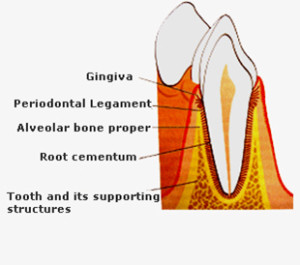
These same fibrous bands play a major role in changing the malaligned / malpositioned teeth into a favorable / desirable position when an orthodontic force is applied. Without these fibrous bands, teeth cannot be moved at all. Teeth are arranged in the form of an arch.
The upper and lower teeth are arranged in a natural curvature allowing for the best fit between the neighbors. It is not uncommon to see a malpositioned / malaligned tooth. When teeth are haphazardly arranged it can lead to facial disfigurement, difficulty to brush, diseases of gum, impairment in speech, and mobility of teeth finally leading to permanent loss of teeth. In fact, well aligned teeth increase the longevity of dental apparatus. A misconception that treatment with braces will loosen the teeth and weaken the dental apparatus is wrong.
Conditions Requiring Braces
-
CROWDED TEETH IN ANTERIOR AND POSTERIOR DENTAL AREA
CROWDED TEETH IN ANTERIOR POSTERIOR DENTAL AREA

- SPACES BETWEEN THE TEETH AND FORWARDLY PLACED TEETH
–
SPACES BETWEEN THE TEETH FORWARDLY PLACED TEETH

- POSTERIOR CROSSBITE , ANTERIOR CROSSBITE AND DEEP BITE
–
POSTERIOR CROSSBITE ANTERIOR CROSSBITE DEEP BITE

- OPEN BITE DUE TO ADVERSE HABITS AND SKELETAL OPEN BITE
–
OPEN BITE DUE TO ADVERSE HABITS SKELETAL OPEN BITE

- HIGHLY PLACED TEETH , CLASS II MALOCCLUSION AND CLASS III MALOCCLUSION
–
HIGHLY PLACED TEETH CLASS II MALOCCLUSION CLASS III MALOCCLUSION

- UNERUPTED PERMANENT TEETH , UNFAVOURABLE ERUPTION AND MULTIPLE LOSS OF PERMANENT TEETH
–
UNERUPTED PERMANENT TEETH UNFAVOURABLE ERUPTION MULTIPLE LOSS OF PERMANENT TEETH

- CLEFT LIP AND PALATE AND FACIAL ASYMMETRY
–
CLEFT LIP AND PALATE FACIAL ASYMMETRY

Who is Going to Put The Braces?
Braces are provided by a qualified MDS specialist in Orthodontics.
Orthodontist
He / she is a dental specialist trained in the treatment of crooked and protruding teeth and management of disproportioned jaws. This master degree is obtained after graduation in dentistry which takes minimum of three years of training in a recognized institution.
Always visit a Qualified Dental Surgeon (BDS graduate from a recognized university) for any type of dental problems. A qualified BDS graduate will be able to make a proper assessment of your complaint and advice the correct treatment required for that particular problem. He/she would be able to perform the basic treatment procedures required for you. Further, if you need any treatment which requires the services of a Specialist Dental Surgeon (one with an MDS qualification), he / she would also be able to refer you to the concerned specialist.
Note: Many dentist claims to able to treat with braces which are not within their purview. You would be at considerable risk by submitting yourself to treatment with a dentist, who is not qualified as an orthodontist. Orthodontic treatment if done wrongly can become irreversible.
Types of Braces
Basically orthodontic appliances are of two types.
- Removable appliances:

As the name implies, these are appliances which can be removed and placed in the mouth by the patient. They are made up of plastic and wire which can bring about minimal tooth movements. Removable appliances play only a supporting role; they are important part of preliminary treatment for a growing child and as a retention appliance for all types of patients. Success of this mode of treatment to a great extent is dependent on patient cooperation. The specialist chooses this method based on the need and demand of the patient.
- Fixed appliances:
As the name implies these are appliances which are fixed to the teeth and removed once the treatment is completed. Fixed braces comprises of tubes that are attached to the molar and brackets which are attached to the rest of the teeth. Both upper and lower teeth carry similar appliances.
Fixed appliances are of 6 types
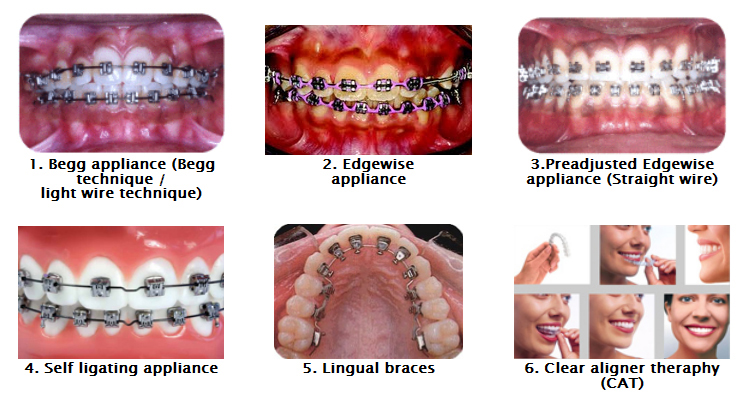
Age Limit for Braces Treatment
There is no age limit for braces treatment. All of us know that we have two sets of teeth in a life time. Milk teeth in the early years and permanent teeth in later years. The transition from milk teeth to permanent teeth takes place over a period of 5 to 13 years of age. Dental problems developed during this period ranging from simple tooth decay to a complex one.
Conditions requiring braces treatment can be prevented to some extent by some procedures. This is called preventive orthodontics.
Conditions which have appeared can be intercepted during the transition period and the severity can be reduced. This is called interceptive orthodontics.
Age is not a guiding factor. The most important is the nature and discrepancy of the problem, onset of the problem and management. So it is always better to consult a specialist (Orthodontist) when in doubt.
Orthodontist and His Role
Diagnosis in orthodontics, as in other disciplines of dentistry and medicine, requires proper collection of information and recognizing the patients need and demand, and formulating a specific treatment that would provide maximum benefit for that particular patient.
Various treatment procedures
- 1. OBSERVION
–

- 2. NON EXTRACTION TREATMENT
–
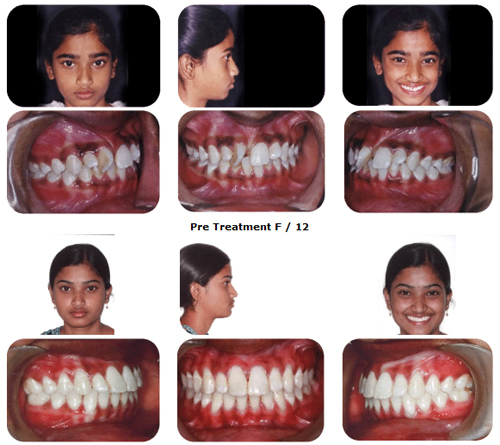
- 3. EXTRACTION TREATMENT AND EXTRACTION AND GENIOPLASTY
–
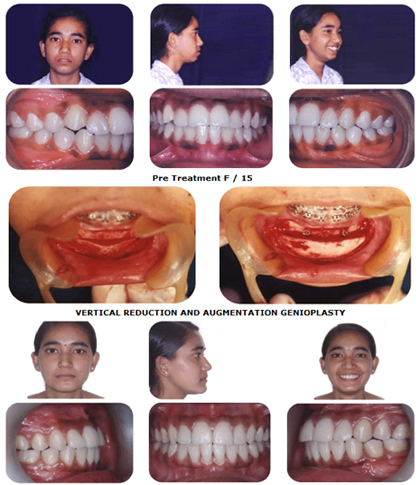
- 4. NON EXTRACTION AND FUNCTIONAL APPLIANCE MODE OF TREATMENT
–
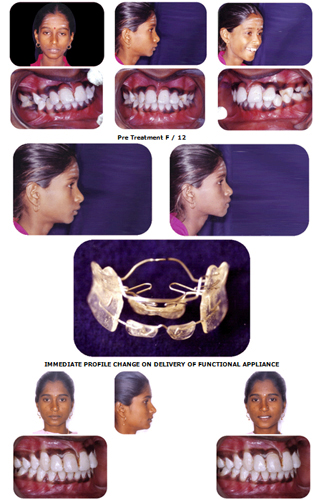
- 5. EXTRACTION AND FUNCTIONAL APPLIANCE MODE OF TREATMENT
–
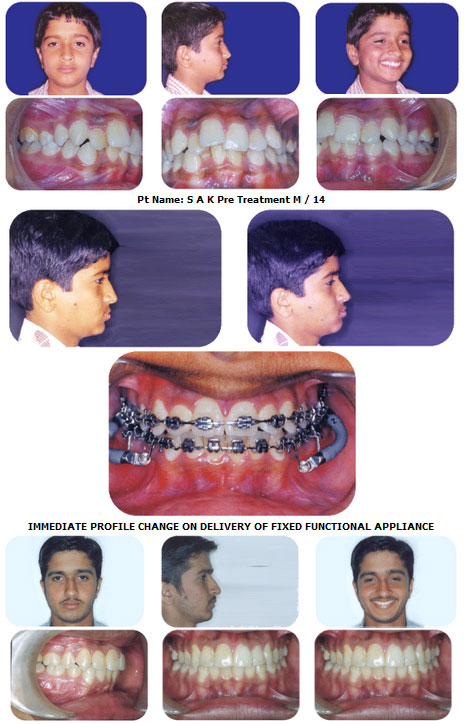
- 6. NON EXTRACTION AND SURGICAL MODE OF TREATMENT
–
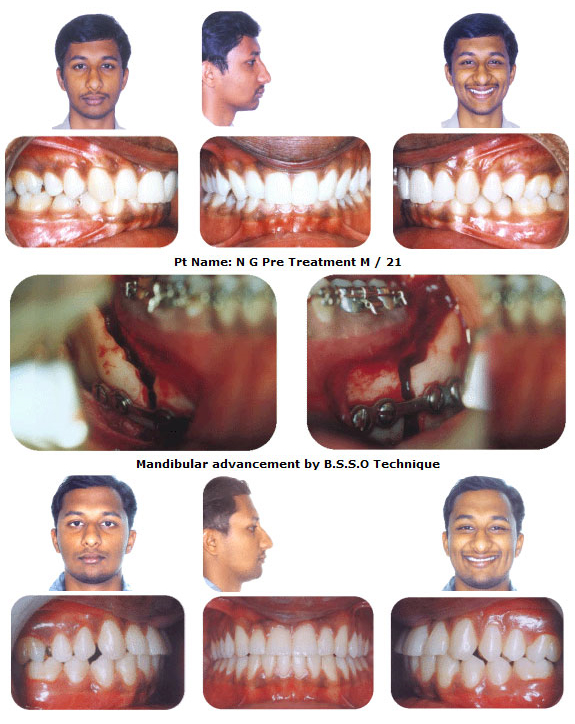
- 7.EXTRACTION AND SURGICAL MODE OF TREATMENT
–
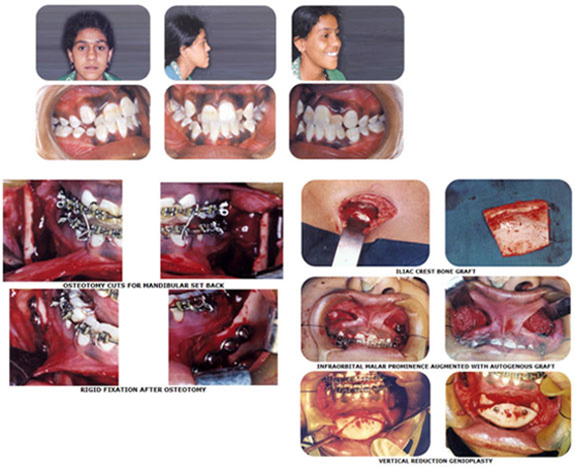
Myths And Facts
Decades ago unqualified dentists (quacks) provided certain dental treatment that was not based on scientific principles. As a result of this wrong and unethical treatment myths developed which became imprinted in people’s minds. Orthodontics today is an advanced specialized branch of dental sciences based on scientific facts. Research in this field has led to better understanding of development of various types of malocclusion and systematic approach to treatment based on these facts. This advancement in dental science has only reduced the myths but not completely eliminated from the minds of people. In the following text few of the myths which still exist are presented along with their related facts for better understanding.
MYTH 1 Professional cleaning / scaling loosens the teeth
FACT 1 Teeth are held firmly by the supporting tissues of the periodontium including bone. Due to bad oral hygiene deposits of tartar / calculus irritates the gums and causes inflammation leading to bleeding of gums. If this bad deposit is not removed the gums may recede and result in the loss of supporting bone leading to mobility of tooth. Professional cleaning removes these deposits and restores the health of supporting structures.
MYTH 2 Cleaning the teeth with finger and powder is better than the tooth brush.
FACT 2 The use of tooth brush with bristles helps to reach almost all the surfaces of the teeth, which is not possible with finger. Hence, it is recommended to use a tooth brush with paste to clean the teeth. Finger can only be used to massage the gums after brushing is complete.
MYTH 3 A child never needs cleaning of milk teeth.
FACT 3 It is a myth that we need not clean a child’s teeth. Children’s teeth are more prone for dental decay or gum problems. So it is advisable to start the habit of cleaning the infant’s teeth soon after they appear in the mouth.
MYTH 4 Milk teeth need not be cared for since these teeth will anyway be replaced by permanent teeth.
FACT 4 Due to early loss of milk teeth, the chewing efficiency is affected. Early loss of milk teeth leads to drifting of adjacent teeth and, closure of the space which is required for eruption of the Permanent teeth. Loss of such space will cause the permanent teeth to erupt in an unfavorable position.
MYTH 5 Bleeding gums should not be brushed.
FACT 5 Bleeding of gums is a sign of active disease. This usually is due to deposits of tartar / plaque. Until this collection is removed, the gums will continue to bleed. Bleeding gums is an indication that the individual needs treatment.
MYTH 6 Thumb sucking need not be intervened.
FACT 6 Thumb sucking is a normal infant habit, which makes the child feel secure and happy until the age of 3 years. However, if the habit persists beyond this age it can lead to forward displacement of the teeth along with spacing. So in such cases, intervention is required to stop this habit.
MYTH 7 Removal of teeth for braces treatment affects vision.
FACT 7 The nerve supply to teeth and eye is entirely different and they are not related. There is a misconception among people that removal of teeth affects vision. Vision is not affected in any way by undergoing orthodontic treatment with extractions.
MYTH 8 Orthodontic procedures are painful.
FACT 8 Most of the dental procedures are carried out under local anesthesia. Orthodontic setup for patient is a painless treatment until and unless it requires extensive procedures. Pain during orthodontic treatment if any, is mild and disappears in a few days.
MYTH 9 Orthodontic treatment should be done only after growth is completed.
FACT 9 In the majority of cases, the best time to treat by orthodontic means is when the patient is actively growing which corresponds to their early adolescent years (7 to 11). During this period, the jaws show profound changes which can be utilized for correcting improper relationship of the jaws in relation to face. This which reduces the severity of the problem, adds psychological benefit to the patient, eliminates extensive surgical procedures that might be needed at a later date, and also aids in the stability of the results.
MYTH 10Orthodontic treatment is a long treatment
FACT 10 he problems, needs and demands of each patient are unique. Therefore, the length and type of treatment can only be determined after thorough evaluation.
Instructions to Orthodontic Patients
Orthodontic Dictionary
The following are the most commonly used terms in orthodontics:
Anterior Teeth: The upper and lower six front teeth on each arch.
Appliance:Anything your orthodontist attaches to your teeth that moves your teeth or changes the shape and/or position of your jaw.
Arch: The entire upper or lower jaw.
Archwire: The metal wire that connects orthodontic brackets. This wire guides the teeth into their new alignment.
Band with bracket:Metal bands (rings) that are generally cemented around the back teeth.
Bond:The seal created by orthodontic cement that holds your appliances in place.
Braces: Fixed orthodontic appliances designed to align teeth.
Brackets: The tiny metal, ceramic or clear brackets that are affixed to each individual tooth on the arch.
Brushing: This is a crucial part of home dental care. Orthodontists recommend those wearing braces to brush after every meal and snack to eliminate bacteria and plaque.
Buccal:The outer (cheek) side of posterior teeth in the lower and upper arches.
Cephalometic X-ray: An x-ray of your head that shows the relative positions and growth of the face, jaws, and teeth.
Chain: Elastics connected together and placed around the brackets to stabilize the archwire and gently close spaces.
Class I Malocclusion: Molars are correctly aligned, but there is an anterior/posterior crossbite, an openbite or overcrowding on the arches.
Class II Malocclusion: Also known as an overbite. The upper front teeth are positioned further forward than the lower teeth.
Class III Malocclusion: Also known as an underbite. The lower front teeth are positioned further forward than the upper front teeth.
Clear aligner Therapy (CAT): An alternative to traditional braces, CAT straightens your teeth with a series of clear, removable, custom-molded aligners. CAT can correct some, but not all, orthodontic problems. Not all patients are candidates for CAT.
Closed Bite: The upper front teeth completely overlap the bottom teeth causing a deep overbite.
Coil Spring: A spring that fits between your brackets and over your archwire to open space between your teeth.
Congenitally Missing Teeth: Some permanent teeth fail to develop and erupt due to genetic factors.
Crossbite: A malocclusion in which the upper back teeth bite inside or outside the lower back teeth, or the lower front teeth bite in front of the upper front teeth.
De-banding: The removal of orthodontic bands from the teeth.
De-bonding: The removal of affixed orthodontic brackets from the teeth.
Diagnostic Records: Records used to assess, plan and implement treatments. These records usually include medical and dental history, radiographs, panoramic radiographs, bite molds and intraoral/extraoral photographs.
Digital Radiograph: Digital x-rays of the teeth which can be viewed, stored and transmitted via computer.
Elastic (Rubber Band): A small rubber band that is hooked between different points on your appliance/braces to provide pressure to move your teeth and jaws to their new position to align your bite.
Elastic Tie: The rubber band that fits around your bracket to hold the archwire in place. These come in a variety of colors.
Eruption: The way in which teeth surface through the gums inside the mouth.
Fixed Orthodontic Appliances: Orthodontic appliances which are affixed to the teeth by the orthodontist and cannot be removed by the patient.
Flossing: An essential part of home care that removes debris and plaque from above and below the gumline.
Functional Appliances: Orthodontic appliances that use the muscle movement created by swallowing, eating and speaking to gently move and align the teeth and jaws.
Gingiva: The gums and soft tissue around the teeth.
Headgear: A removable appliance comprised of a brace and external archwire. This device modifies growth and promotes tooth movement.
Impressions: The process of making a model of your teeth by biting into a soft material that hardens into a mold of your teeth. Your orthodontist will use these impressions to prepare your treatment plan.
Interceptive Treatment: Treatment performed on children who have a mixture of adult and baby teeth. Early treatment can help reduce the need for major orthodontic treatment in the future.
Ligating Modules: An elastic donut-shaped ring which helps secure the archwire to the bracket.
Ligation: Securing the archwire to the brackets.
Lingual Side: The side of the teeth (in both arches) that is closest to the tongue.
Lower Expander: A device that makes your lower jaw/bone that teeth sit on wider.
Malocclusion: Literally means “bad bite” in Latin, and refers to teeth that do not fit together correctly.
Mandible: The lower jaw.
Maxilla: The upper jaw.
Mouthguard: A removable plastic or rubber device that protects teeth and braces from sporting injuries.
Open Bite: Upper and lower teeth fail to make contact with each other. This malocclusion is generally classified as anterior or posterior.
Orthodontics: The unique branch of dentistry concerned with diagnosing, preventing and correcting malocclusions and jaw irregularities.
Orthodontist: A dental specialist who prevents, diagnoses and treats jaw irregularities and malocclusions. Orthodontists must complete two or three additional years of college after dental school and complete a residency program.
Palatal Expander: A device that makes your upper jaw wider.
Panoramic X-ray:An x-ray that rotates around your head to take pictures of your teeth, jaw and other facial areas.
Plaque: The sticky film of saliva, food particles and bacteria that contributes to gum disease and tooth decay.
Posterior Teeth:Back teeth.
Removable Appliance:An orthodontic brace or device that can be removed at will by the patient. It must be worn for the designated amount of time each day to be effective.
Retainer: An appliance that is worn after your braces are removed, the retainer attaches to your upper and/or lower teeth to hold them in place. Some retainers are removable and others are bonded to the tongue-side of several teeth.
Separator (or Spacer):A small rubber ring that creates space between your teeth (usually molars) before the bands are fitted and attached.
Space Maintainer: A fixed appliance used to hold space for permanent (adult) tooth. This is usually used when a baby tooth has been lost earlier than anticipated.
Wax: Orthodontic relief wax is a home care remedy used to alleviate irritations caused by braces.
Wire: he metal wire that acts as a track to guide your teeth along as they move. It is attached to the brackets to gently move the teeth into proper alignment. It is changed periodically throughout treatment as your teeth move to their new positions.